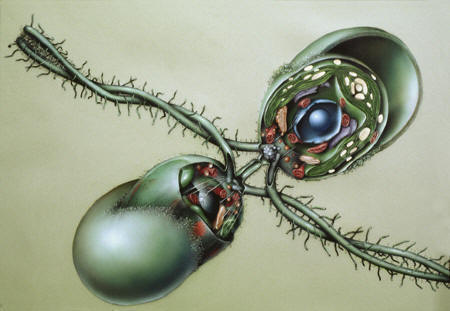|
|
|
Chlamydomonas' life cycle is very interesting as well as extremely effective (I know from first hand experience from having to replace their media). Chlamydomonas cells during their vegetative state are haploid but when deprived of oxygen will go through sexual reproduction to form a diploid zygote which is very resistant to adverse conditions. |
|
In nitrogen free media Chlamydomonas will form gametes and go through sexual reproduction. During sexual reproduction two gametes of opposite mating type (type+/type-) will fuse. As seen above reproduction within the species C. reinhardtii involves the fusion of cells. In order to align themselves correctly for fusion they must first entangle their flagella after the two opposite mating types are positioned properly the cells extend mating structures, shed their cell walls, and fuse into a single resilient diploid zygote. |
|
|
| After conditions return to normal and nitrogen is restored to the environment the zygote will break open releasing four or more new cells referred to as meiospores which eventually develop into larger vegetative cells. As you can see above during asexual reproduction vegetative cells will undergo mitosis to release two or more vegetative cells. |
|
|
|
|
|
Under perfect growth conditions Chlamydomonas can go
through mitosis two or three times before actual breaking through the
cell wall and releasing multiple daughter cells. |




















.jpg)